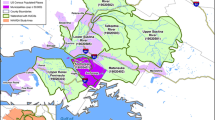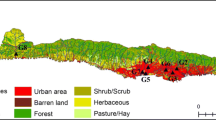Abstract
The hydrological impact of climate change is assessed for 28 watersheds located within the Southeast United States using output from global climate models (GCMs) from the Climate Model Intercomparison Project phase 3 (CMIP3) and phase 5 (CMIP5) run. Subsequently, the impact of projected change in seasonal streamflow is derived by propagating projected scenarios, generated using changes derived from GCMs and weather generators, through a suite of conceptual hydrological models. Analysis shows that the spread in the magnitude of change in temperature and rainfall for CMIP3 is wider than that for CMIP5. The reduction in the spread among many factors may be attributed to improved physics, model number and resolution, and emission scenarios. The spread in projected change in temperature (precipitation) increases (decreases) from southernmost to northernmost latitude. Hydrological projection with CMIP3 output for the 2070s shows that streamflow decreases for most of the watersheds in spring and summer and increased in fall. In contrast, CMIP5 results show an increase in flow for all seasons except with the high-end scenarios in spring. However, the uncertainty in projections in streamflow is high with model uncertainty dominating emission scenario. The variability in prediction uncertainty among watersheds is partly explained by the variability in wetness index. The probability distribution function for projected seasonal flow for each scenario is markedly wide and therefore reflects that the uncertainty associated with using multiple GCMs from both CMIP3 and CMIP5 experiment is high which makes design and implementation of adaption measure a difficult task.






Similar content being viewed by others
References
Bastola S, Misra V (2013) Evaluation of dynamically downscaled reanalysis precipitation data for hydrological application. Hydrol Process. doi:10.1002/hyp.9734
Bastola S, Murphy C, Sweeney J (2011) The sensitivity of fluvial flood risk in irish catchments to the range of IPCC AR4 climate change scenarios. Sci Total Environ 409:5403–5415
Beven KJ, Binley AM (1992) The future of distributed models: model calibration and uncertainty prediction. Hydrol Process 6:279–298
Booth BBB, Bernie D, McNeall D, Hawkins E, Caesar J, Boulton C, Friedlingstein P, Sexton D (2012) Scenario and modelling uncertainty in global mean temperature change derived from emission driven global climate models, earth syst. Dyn Discuss 3:1055–1084. doi:10.5194/esdd-3-1055-2012
Boyle D (2001) Multicriteria calibration of hydrological models. PhD dissertation. Tucson, AZ: Department of Hydrology and Water Resources, University of Arizona
Christensen NS, Wood AW, Voisin N, Lettenmaier DP, Palmer RN (2004) Effects of climate change on the hydrology and water resources of the colorado river basin. Clim Change 62(1–3):337–363
Fowler HJ, Blenkinsopa S, Tebaldi C (2007) Review: linking climate change modelling to impacts studies: recent advances in downscaling techniques for hydrological modelling. Int J Climatol 27:547–1578
Guilyardi E, Bellenger H et al (2012) A first look at ENSO in CMIP5. Clivar Exch 58 17(1):29–32
Harding BL, Wood AW, Prairie JR (2012) The implications of climate change scenario selection for future streamflow projection in the upper colorado river basin. Hydrol Earth Syst Sci 16:3989–4007
Hargreaves GL, Hargreaves GH, Riley JP (1985) Irrigation water requirement for senegal river basin. J Irrig Drain Eng ASCE 111(3):265–275
Hawkins ED, Sutton R (2009) The potential to narrow uncertainty in regional climate predictions. Bull Am Meteorol Soc 90:1095–1107
Karl TR, Melillo JM, Peterson TC (eds) (2009) Global Climate Change Impacts in the United States. Cambridge University Press, New York
Kim HM, Webster PJ, Curry JA (2012) Evaluation of short-term climate change prediction in multi-model CMIP5 decadal hindcasts. Geophys Res Lett 39:L10701. doi:10.1029/2012GL051644
Kuntti R and Sadlacek J (2012) Robustness and uncertainties in the new CMIP5 climate model projections doi:10.1038/NCLIMATE1716
Ledbetter R, Prudhomme C, Arnell N (2011) A method for incorporating climate variability in climate change impact assessments: sensitivity of river flows in the eden catchment to precipitation scenarios. Clim Change 113:803–823
Madsen H (2000) Automatic calibration of a conceptual rainfall–runoff model using multiple objectives. J Hydrol 235:276–288
Maslin M, Austin P (2012) Climate models at their limit? Nature 486:183–184
Maurer EP (2007) Uncertainty in hydrologic impacts of climate change in the Sierra Nevada mountains, California under two emissions scenarios. Clim Change 82:309–332
Meehl GA, Bony S (2011) Introduction to CMIP5. Clivar Exch 56 16(2):4–5
Meehl G, Covey C, Delworth T, Latif M, McAvaney B, Mitchell J, Stouffer R, Taylor K (2007) The WCRP CMIP3 multimodel dataset. Bull Am Meteorol Soc 88:1383–1394
Misra V, DiNapoli S (2012) Understanding wet season variations over Florida Clim. Dyn. doi:10.1007/s00382-012-1382-4
Mo KC, Schemm JKE, Yoo SH (2009) Influence of ENSO and the Atlantic multidecadal oscillation on drought over the United States. J. Clim 22:5962–5982
Moss et al (2010) The next generation of scenarios for climate change research and assessment. Nature 463:747–756. doi:10.1038/nature08823
Richarsdon CW, Wright DA (1984) WGEN: a model for generating daily weather variables U.S. Department of Agricultural, Agricultural Research Service ARS-8, p 83
Schaake J, Cong S, Duan Q (2006) US mopex datasets, IAHS publication series (https://ereports-ext.llnl.gov/pdf/333681.pdf)
Sugawara M (1995) Tank model. In: Singh VP (ed) Computer models of watershed hydrology. Water Resources Publications, Littleton, Co, pp 165–214
Taylor KE, Stouffer RJ, Meehl GA (2012) An overview of CMIP5 and the experiment design. Bull Am Meteorol Soc 93:485–498. doi:10.1175/BAMS-D-11-00094.1
Wilks DS (1992) Adapting stochastic weather generation algorithms for climate changes studies. Clim Change 22:67–84
Wood AW, Leung LR, Sridhar V, Lettenmaier DP (2004) Hydrologic implications of dynamical and statistical approaches to downscaling climate model outputs. Clim Change 62:189–216. doi:10.1023/B:CLIM.0000013685.99609.9e
Acknowledgments
I acknowledge the editorial assistance of Kathy Fearon of the Center for Ocean-Atmospheric Prediction Studies, Florida State University in preparing this manuscript. This work was supported by NOAA Grant NA07OAR4310221 and USGS Grant 06HQGR0125. The paper has been greatly improved by the comments and suggestions from three anonymous reviewers and Dr V Misra. Its contents are solely the responsibility of the author and do not necessarily represent the official views of the acknowledged funding agencies.
Author information
Authors and Affiliations
Corresponding author
Electronic supplementary material
Below is the link to the electronic supplementary material.
Rights and permissions
About this article
Cite this article
Bastola, S. Hydrologic impacts of future climate change on Southeast US watersheds. Reg Environ Change 13 (Suppl 1), 131–139 (2013). https://doi.org/10.1007/s10113-013-0454-2
Received:
Accepted:
Published:
Issue Date:
DOI: https://doi.org/10.1007/s10113-013-0454-2




